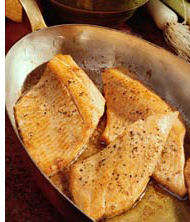Methylmercury is a lot more toxic than inorganic mercury. Unfortunately most mercury found in fish is in the organic form. An interesting question is, whether food processing such as cooking or frying can alter the ratio of inorganic/organic mercury within the fish meal.
This shockingly simple question came into the mind of
Gordon Brown, an expert on the geochemistry of toxic metals who works in a state-of-the-art laboratory at Stanford University. Having a good understanding of mercury speciation and its effect on toxicity, Brown knew that heat had the potential to alter the molecular structure of mercury and thus its toxicity.

Armed with a frying pan and samples from the local fish market, Brown designed an experiment to test the hypothesis that cooked tuna contains less methyl mercury than uncooked tuna.
The results surprised him. Compared to raw fish, cooking did not reduce the methyl mercury levels as he had anticipated. In fact, the amount of methylmercury appeared to increase with the duration of cooking time, although Brown says that this trend might be due to the underlying variation of his experiments, rather than a true indication that methylmercury levels are increased by the cooking process. At best, he says, "there is no effect". He also is quick to point out that his kitchen experiments are not publishable data, and therefore can't be used to draw any official conclusions.
However, the result is in line with the analytical experience that quite harsh conditions using oxidizing acids and elevated temperatures are necessary to break down organic mercury. Processing the fish by elevated temperatures might also enhance the extractability of methyl mercury and thus lead to apparently higher methylmercury values than found in raw fish, a fact that is used to enhance extraction efficiency by using microwave-assisted extraction.
Michael Sperling
 Related Studies
Related Studies:
Effect of food processing on metal speciation:

Robert C. Massey, H. Crews,
Les Ebdon, J.R. Dean,
The effects of cooking and simulated gastro-intestinal digestion on the speciation of cadmium in pig kidney, Peter Brätter, Peter Schramel, Trace Element Analytical Chemistry in Medicine and Biology, Walter de Gruyter, Berlin - New York, Vol. 5 (1988) 180-187.

Helen M. Crews, Philip A. Clarke, D. John Lewis, Linda M. Owen, Paul R. Strutt, Andrés Izquierdo,
Investigation of selenium speciation in in-vitro gastrointestinal extracts of cooked cod by HPLC-ICP-MS and electrospray-MS, J. Anal. At. Spectrom., 11/12 (1996) 1177-1182. DOI:
10.1039/JA9961101177
J.T. van Elteren, Z. Slejkovec,
Ion-exchange separation of eight arsenic compounds by high-performance liquid chromatography-UV decomposition-hydride generation-atomic fluorescence spectrometry and stability tests for food treatment procedures, J. Chromatogr. A, 789/1-2 (1997) 339-348. DOI:
10.1016/S0021-9673(97)00703-6
V. Devesa, A. Martínez, M.A. Súñer, D. Vélez, C. Almela, R. Montoro,
Effect of Cooking Temperatures on Chemical Changes in Species of Organic Arsenic in Seafood, J. Agri. Food Chem., 49/5 (2001) 2272-2276.
DOI:
10.1021/jf0013297

Vicenta Devesa, Mari Luz Macho, Mercedes Jalón, Inés Urieta, Ociel Muñoz, María Angeles Súñer, Fernando López, Dinoraz Vélez, Rosa Montoro,
Arsenic in Cooked Seafood Products: Study on the Effect of Cooking on Total and Inorganic Arsenic Contents, J. Agri. Food Chem., 49 (2001) 4132-4140.
DOI:
10.1021/jf010274l

V. Devesa, A. Martinez, M.A. Súñer, V. Benito, D. Vélez, R. Montoro,
Kinetic study of transformations of arsenic species during heat treatment, J. Agri. Food Chem., 49 (2001) 2267-2271.
DOI:
10.1021/jf001328e
C.F. Harrington, S. Elahi, S.A. Merson, P. Ponnampalavanar,
A Method for the Quantitative Analysis of Iron Speciation in Meat by Using a Combination of Spectrophotometric Methods and HPLC Coupled to Sector Field Inductively Coupled Plasma Mass Spectrometry, Anal. Chem., 73/18 (2001) 4422-4427.
DOI:
10.1021/ac010279h

K. Hanaoka,
Walter Goessler, H. Ohno, K.-J. Irgolic, T. Kaise,
Formation of toxic arsenical in roasted muscles of marine animals, Appl. Organomet. Chem., 15/1 (2001) 61-66.
DOI: 10.1002/1099-0739(200101)15%3A1<61%3A%3AAID-AOC70>3.0.CO%3B2-2

A.I. Cabanero, Y. Madrid,
Carmen Cámara,
Selenium and mercury bioaccessibility in fish samples: an in vitro digestion method, Anal. Chim. Acta, 526/1 (2004) 51-61.
DOI:10.1016/j.aca.2004.09.039
Concepcíon Almela, José Moisés Laparra, Dinoraz Vélez, Reyes Barberá, Rosaura Farré, Rosa Montoro,
Arsenosugars in Raw and Cooked Edible Seaweed: Characterization and Bioaccessibility, J. Agri. Food Chem., 53/18 (2005) 7344-7351.
DOI: 10.1021/jf050503u
V. Devesa, M.A. Súñer, S. Algora, D. Vélez, R. Montoro, M. Jalón, I. Urieta, M.L. Macho,
Organoarsenical Species Contents in Cooked Seafood, J. Agri. Food Chem., 53/22 (2005) 8813-8819.
DOI: 10.1021/jf050499m Related EVISA News:
Related EVISA News:
 December 11th, 2003: No degradation of TBT in seafood during cooking
December 11th, 2003: No degradation of TBT in seafood during cooking
 April 27, 2004: New kind of mercury found in fish
April 27, 2004: New kind of mercury found in fish August 29, 2005: Is methyl mercury limiting the delight of
seafood ? - To answer this question is a challenge for elemental
speciation analysis
August 29, 2005: Is methyl mercury limiting the delight of
seafood ? - To answer this question is a challenge for elemental
speciation analysis
last time modified: March 7, 2024